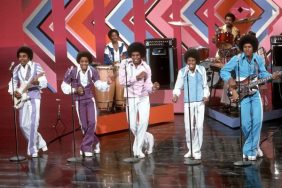Photo: With The Supremes, Berry Gordy hails members of the Motown house band, at left, and his Holland/Dozier/Holland hitmakers, in December 1965. LOOK Magazine Photograph Collection, Library of Congress, Prints & Photographs Division [LC-L901A- 65-26- 16-VVV, no. 10]
Motown: The sound of young America, coming straight out of Motor City/Detroit was the perfect blend of soul and pop. It was the home of legends from Marvin Gaye, Smokey Robinson, and Stevie Wonder to the Jackson 5, the Supremes, and Diana Ross. And it was all the brainchild of Berry Gordy, Jr., a local songwriter who quickly realized that producing records and owning the publishing was the best way to make bank.
Also: “Let Us March On” Showcases Lee Friedlander’s Unseen Civil Rights Photographs
After launching Tamla and Motown labels, Gordy purchased the property that would become the legendary Hitsville U.S.A., in 1959. The multi-purpose building served as a recording studio, administrative offices, tape library, control room, and living quarters for Gordy in those early formative years. He put several family members in key roles, and made Smoke Robinson VP. Then, on April 14, 1960, Berry Gordy, Jr. incorporated the Motown Record Corporation, and that same year the company had its first number 1 R&B hit, the Miracles, “Shop Around.”

The Temptations, The Miracles, Stevie Wonder, Martha & the Vandellas and The Supremes at EMI Records in March 1965, for the UK launch of the Tamla-Motown label. Courtesy of the Paul Nixon Collection.
Between 1961 and 1971, Motown lead the charts with 110 top 10 hits, defining the sound of the times. Then in 1972, the company moved to Los Angeles, where it had a second life. Through the ‘70s, ‘80s, and ‘90s, until the company’s acquisition by Universal in 2005, Motown stayed on the cutting edge, not only making music but also producing films including Mahogany, The Wiz, and The Last Dragon.
In celebration, Thames & Hudson has released Motown: The Sound of Young America by Adam White. At 400 pages, with 1,00 illustrations in color and black and white, this is the official visual history of Motown. The book opens with scenes of the 1967 Detroit Riots that began after local police broke into an unlicensed nightclub on 12th Street. Just eight years earlier, Gordy had lived nearby on Gladstone Street, the location of his very first record release.
But things had changed—both for Detroit and for Motown. The riots became the point of no return, a point at which neither would ever be the same. In the ashes of the riots, Gordy hosted the company’s first-ever national sales convention, attracting a nearly all-white audience, working to maintain the crossover appeal that took his company to the top. Within 24 hours, the company took a record $4 million ($28 million today) in orders, making it the single biggest day of business in Motown’s history and showing Gordy knew exactly how to play the crowd.
This is but one of the beautifully told stories in Motown: The Sound of Young America. The definitive volume of the record label, the book provides more than just the story of the music, but of the people, places, and the culture that made the label a legend. It’s like every “Unsung” and “Behind the Music” wrapped up in one, sharing the details of the company’s rise to the top and its ability to hold that place for years—giving the inside scoop on how Berry Gordy Jr. and his line-up of all-star artists navigated the choppy waters of wealth and fame. The intimate stories and archival images provide an inside look into the personalities who made the label an unstoppable force of nature song after song, album after album, making it a treasure trove of moments and memories to enjoy time and again.
Special Event:
Author Adam White will be discussing Motown: The Sound of Young America at a panel discussion at the Los Angeles Times Festival of Books on Sunday, April 23, 2017 at 3:30pm.
Miss Rosen is a journalist covering art, photography, culture, and books. Her byline has appeared in L’Uomo Vogue, Whitewall, The Undefeated, Dazed Digital, Jocks and Nerds, and L’Oeil de la Photographie. Follow her on Twitter @Miss_Rosen.
Motown
-
"Motown: The Sound of Young America"

Florence Ballard, Mary Wilson and Diana Ross in London’s Manchester Square, outside the headquarters of EMI Records, in October 1964.
Courtesy of EMI Group Archive Trust -
"Motown: The Sound of Young America"

Martha & the Vandellas set off for one of the Motortown Revue tours.
Courtesy of the Paul Nixon Collection -
"Motown: The Sound of Young America"

Berry Gordy presents a copy of an LP to Rev. Martin Luther King of his address to the Freedom Rally held in Detroit on June 23, 1963, pictured with singer and civil rights activist Lena Horne and jazz musician Billy Taylor, the composer of “I Wish I Knew How It Would Feel to Be Free.”
Motown Records Archives. Courtesy of the EMI Archive Trust and Universal Music Group. -
"Motown: The Sound of Young America"

Rev. Martin Luther King’s defining “I have a dream” speech was the climax of the rally for “job and freedom” staged Wednesday, 28 August 1963 in Washington DC. An estimated 200,000 people descended on the capital, their presence representing a very public pressure for the passage of civil rights legislation being considered in Congress. In October, Motown released The Great March on Washington, an album featuring Rev. King and the day’s other orators, which also included a version of one of the marcher’s anthems, “We Shall Overcome,” sung by Liz Lands.
LOOK Magazine Photograph Collection, Library of Congress, Prints & Photographs Division [LC-L901A- 63-1495, no.7] -
"Motown: The Sound of Young America"

The Temptations, The Miracles, Stevie Wonder, Martha & the Vandellas and The Supremes at EMI Records in March 1965, for the UK launch of the Tamla-Motown label.
Courtesy of the Paul Nixon Collection -
"Motown: The Sound of Young America"

Seen at a Detroit nightclub in 1964 are, from L to R, Levi Stubbs of The Four Tops, Motown songwriter/producer Ivy Jo Hunter, Stevie Wonder and Marvin Gaye, with musicians Dan Turner on sax and James Jamerson on bass.
Private collection -
"Motown: The Sound of Young America"

Diana Ross, Berry Gordy and Barney Ales prepare to set sail on a yacht from Miami, circa 1966. After their Copacabana success, The Supremes were in demand from other cabaret nightspots around the US such as Miami’s Eden Roc and Deauville hotels.
Courtesy of Barney Ales -
"Motown: The Sound of Young America"

With The Supremes, Berry Gordy hails members of the Motown house band, at left, and his Holland/Dozier/Holland hitmakers, in December 1965.
LOOK Magazine Photograph Collection, Library of Congress, Prints & Photographs Division [LC-L901A- 65-26- 16-VVV, no. 10] -
"Motown: The Sound of Young America"

The Gordys and Robinson are poolside once more.
Courtesy of Barney Ales -
"Motown: The Sound of Young America"

Tammi Terrell gives a wave in the street outside Motown HQ.
Courtesy of the Paul Nixon Collection -
"Motown: The Sound of Young America"

Smokey and Claudette Robinson rest on the journey home.
Courtesy of Barney Ales -
"Motown: The Sound of Young America"

Behind the scenes at the Motown Center, February 1970; two years earlier, the company had traded its “sideways scraper” on West Grand for this conventionally vertical workspace at 2457 Woodward Avenue. Top row, center and right: Esther Edwards and Barney Ales. Second Row, left to right: Ralph Seltzer, Miller London and Like Lushka. Third Row, left to right: Gordon Prince with secretary Thelma Leverett, Fuller Gordy and Esther Edwards. Bottom row, left to right: Tom Schlesinger, Billie Jean Brown and Schlesinger with Ales.
Courtesy of Barney Ales -
"Motown: The Sound of Young America"

Stevie Wonder with Mick Jagger on The Rolling Stones’ North American tour in 1972.
Courtesy of EMI Group Archive Trust -
"Motown: The Sound of Young America"

Stevie Wonder with David Bowie in 1973.
Courtesy of EMI Group Archive Trust -
"Motown: The Sound of Young America"

The Jackson 5 taping their ABC-TV network special Goin’ Back to Indiana, in Los Angeles in July 1971.
Motown Records Archives. Courtesy of the EMI Archive Trust and Universal Music Group. -
"Motown: The Sound of Young America"

The Undisputed Truth in 1971: Joe Harris, Brenda Joyce Evans (front) and Billie Rae Calvin.
Motown Records Archives. Courtesy of the EMI Archive Trust and Universal Music Group. -
"Motown: The Sound of Young America"

Motown: The Sound of Young America by Adam White with Barney Ales and a foreword by Andrew Loog Oldham
Published by Thames & Hudson







